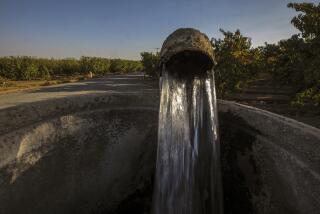Water Scarcity, Air Quality
- Share via
I thank Stall for his highly informative Column One article on the current drought. Public education on California’s water issues is badly needed.
In focusing on the deficiencies of the state’s water system, however, Stall has missed the crux of the problem: California is a largely arid state, and its carrying capacity for agriculture and urban growth is finite. Like so many reclamation officials of the past, he describes solutions largely in terms of expanding water storage and transfer facilities. He cites a “breakdown of the kind of visionary leadership that once primed the state for population booms of the past.” The “visionary leadership” he refers to includes William Mulholland and government officials who engaged in shameful tactics to procure Owens Valley water, which served initially to line the pockets of a few major San Fernando Valley landholders. A number of environmentally disastrous and costly reclamation projects have been constructed chiefly for the benefit of major agribusiness interests at public expense. As for the booms made possible by the creation of the mammoth water projects Stall documents so well, they have only led to the inevitability of more water shortages and more dam building--a never-ending cycle with increasing costs and diminishing returns.
It is time we faced the harsh geographic and climatic reality of our state and stopped looking to fiscally irresponsible, environmentally unsound engineering fixes to solve the problem. California’s overextended budget and natural resources can only yield so much. Reallocation of our limited water resources, improved public perception of the state’s truly arid nature coupled with aggressive conservation, and the political will to limit runaway growth are the most crucial elements in avoiding a water crisis of catastrophic proportions in the future.
ROBERT MARIN, San Diego
More to Read
Sign up for Essential California
The most important California stories and recommendations in your inbox every morning.
You may occasionally receive promotional content from the Los Angeles Times.













